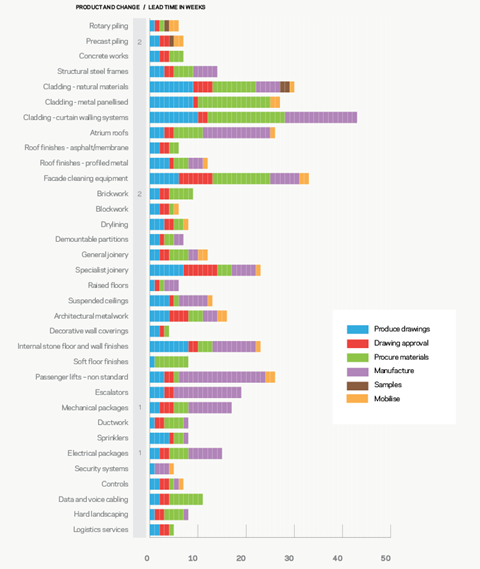While there is little movement in lead times so far, increased enquiries and workload may signal significant increases to come. Brian Moone of Mace Business School reports
01 / GOING UP
▲Pre-cast piling
▲B��������ɴǰ���
▲Electrical packages
▲Mechancial packages
02 STAYING LEVEL
▶ Piling (rotary)
▶ Piling (pre-cast)
▶ Concrete works
▶ Structural steel frames
▶ Cladding - natural materials
▶ Cladding - metal panellised
▶ Cladding - curtain walling systems
▶ Atrium roofs
▶ Roof finishes - asphalt/membrane
▶ Roof finishes - profiled metal
▶ Facade cleaning equipment
▶ Brickwork
▶ Blockwork
▶ Metal doors
▶ Drylining
▶ Demountable partitions
▶ General joinery
▶ Specialist joinery
▶ Raised floors
▶ Suspended ceilings
▶ Architectural metalwork
▶ Decorative wall coverings
▶ Internal stone floor and wall finishes
▶ Soft floor finishes
▶ Passenger lifts (non-standard)
▶ Escalators
▶ Electrical package
▶ Mechanical package
▶ Ductwork
▶ Sprinklers
▶ Security systems
▶ Controls
▶ IT infrastructure equipment
▶ Data and voice cabling
▶ Hard landscaping
▶ Logistics services
03 / LEAD TIMES SUMMARY
There is no change for rotary piling ▶ this quarter, having increased last quarter. All companies are reporting being busier with both workload and enquiries. Pre-cast piling ▲ has increased by a further two weeks due to increase in the workload.
Concrete works ▶ lead times remain at seven weeks for the second quarter and structural steel frames ▶ remain at 14 weeks.
The increase last quarter in cladding - natural material ▶ has stabilised this quarter with lead times remaining at 30 weeks and contractors do not anticipate any increase for the next six months.
Cladding - metal panellised system ▶ lead times have remained at 27 weeks since Q1 2010 and cladding - curtain walling system ▶ at 43 weeks since the beginning of 2012 with no changes forecast despite workload and enquiries increasing.
Atrium roof ▶ lead times remain at 26 weeks and roof finishes - asphalt / membrane ▶ at seven weeks for the third quarter. Roof finish - profiled metal ▶ lead times have remained at 12 weeks since mid-2009 with no change forecast.
Facade cleaning equipment ▶ lead times remain at 33 weeks. Companies are currently busy and enquiries have picked up in the UK but they anticipate lead time reductions due less global activity and improved efficiencies.
Brickwork ▲ lead times have increased by two weeks to eight weeks, the third consecutive increase in succession, and double the lead times of mid-2011. This is due to the reduced stock held by manufacturers as well as a shortage of haulage contractors that are able to deliver the bricks.
Blockwork ▶ lead times remain at six weeks, but companies are forecasting longer lead times over the next six months.
Drylining ▶ lead times remain stable at eight weeks, with no changes forecast.
Demountable partitions ▶ lead times remain at seven weeks, general joinery remain at 12 weeks, and specialist joinery ▶ at 23 weeks despite being busier than last quarter.
Raised floors ▶ lead times remain static at six weeks with no change since 2007. Contractors’ enquiries and workload has increased and they anticipate longer lead times in the next six months.
Suspended ceiling ▶ lead times are also static.
Architectural metalwork lead times remain at 16 week and there is no increase forecast for the next six months.
Decorative wall covering ▶lead times remain at four weeks and internal stone floor and wall finish ▶ at 24 weeks. No increases are anticipated.
Soft floor finish ▶ lead times have remained at eight weeks since the end of 2010.
Passenger lift-non standard ▶ lead times remain at 26 weeks and escalators ▶at 19 with no change forecast for the next six months.
Electrical package ▲ lead times have increased by one week to 15 weeks, the first increase since mid-2009 and times are expected to rise in the next six months.
Mechanical package ▲ lead times have increased by one week to 17 weeks. Contractors are anticipating a further increase in the next six months as a result of increased enquiries and workload.
The lead time for ductwork ▶ remains at eight weeks with no change forecast for the next six months. Sprinklers ▶ stay at eight weeks.
Security systems ▶ lead times have remained static at five weeks for over two years but with enquiries and workload up this is anticipated to increase in the next six months.
Controls ▶ lead times remain at seven weeks with no change forecast despite increased workload and enquiry levels and IT infrastructure equipment ▶ at six. Longer lead times are anticipated.
Data and voice cabling ▶ lead times remain at 11 weeks, hard landscaping ▶ at eight weeks and logistics services ▶ at five weeks.
There are clear signs of optimism with the majority of the companies reporting increased levels of enquiries and workload, and many are forecasting that increases will occur in the next six months. The early upfront trades are among the first to increase lead times with precast piling up by two weeks following the increase in rotary piling last quarter. Brickwork has gone up for the second quarter in succession as a result of brick shortages and continued problems with availability of haulage for delivery. Mechanical and electrical packages are both reporting an increase of one week.
Data capture and analysis by Mace Business School. For more details on the article and contributors, please visit

























No comments yet